Is Organic Food Consumption Associated with Other Sustainable Food-Related Behaviors? Insights from a Survey in the Capital City of Poland
Abstract
1. Introduction
2. Materials and Methods
2.1. Data Collection: Household Survey
2.2. Data Analysis
3. Results and Discussion
3.1. Organic Consumption in Warsaw—Overview
3.2. Associations Between Organic and Sustainable Food-Related Behaviors in Warsaw
3.2.1. Dietary Behavior
3.2.2. Sustainability Awareness, Food Choice Determinants, Associations with Organic Food, and Shopping Places
3.2.3. Willingness to Change Food Habits to More Sustainable Ones
4. Conclusions
Supplementary Materials
Author Contributions
Funding
Institutional Review Board Statement
Informed Consent Statement
Data Availability Statement
Acknowledgments
Conflicts of Interest
Abbreviations
| CSA | Community-supported agriculture |
| DP | Dietary pattern |
| FAO | The Food and Agriculture Organization of the United Nations |
| FS | Food system |
| GMOs | Genetically modified organisms |
| GPP | Green Public Procurement |
| HHS | Household survey |
| KMO | Kaiser–Meyer–Olkin |
| MUFPP | Urban Food Policy Pact |
| NDGs | National dietary guidelines |
| PHD | Planetary Health Diet |
| SFS | Sustainable food system |
| SDGs | Sustainable Development Goals |
| SFC | Sustainable food consumption |
| UN | United Nations |
| V4 | Visegrad Group |
| WHO | The World Health Organization |
Appendix A
| Variables | N = 449 | % |
|---|---|---|
| Gender | ||
| Male | 76 | 16.9 |
| Female | 373 | 83.1 |
| Age in years (M ± SD) | 38.6 ± 13.2 | |
| Age in categories | ||
| 18–26 | 97 | 21.6 |
| 27–35 | 95 | 21.2 |
| 36–44 | 119 | 26.5 |
| 45–53 | 72 | 16.0 |
| 54 or more | 66 | 14.7 |
| Level of education | ||
| Secondary or apprenticeship | 91 | 20.3 |
| Bachelor’s degree or equivalent level | 68 | 15.1 |
| Master’s degree or equivalent level | 248 | 55.2 |
| Doctoral studies and/or higher | 42 | 9.4 |
| Disposable net household income per year (PLN) | ||
| I prefer not to answer | 109 | 24.3 |
| Up to 30,000 (lower) | 34 | 7.6 |
| 30,001–45,000 (low) | 31 | 6.9 |
| 45,001–60,000 (medium-low) | 37 | 8.2 |
| 60,001–77,000 (medium) | 33 | 7.4 |
| 77,001–96,000 (medium-high) | 45 | 10.0 |
| 96,001–120,000 (high) | 53 | 11.8 |
| More than 120,000 (highest) | 107 | 23.8 |
References
- Araújo, R.G.; Chavez-Santoscoy, R.A.; Parra-Saldívar, R.; Melchor-Martínez, E.M.; Iqbal, H.M.N. Agro-Food Systems and Environment: Sustaining the Unsustainable. Curr. Opin. Environ. Sci. Health 2023, 31, 100413. [Google Scholar] [CrossRef]
- The EAT-Lancet Commission on Food, Planet, Health. Available online: https://eatforum.org/content/uploads/2023/12/EAT-Lancet-Global_Consultation_Report_v2.1.pdf (accessed on 1 April 2025).
- Willett, W.; Rockström, J.; Loken, B.; Springmann, M.; Lang, T.; Vermeulen, S.; Garnett, T.; Tilman, D.; DeClerck, F.; Wood, A.; et al. Food in the Anthropocene: The EAT–Lancet Commission on Healthy Diets from Sustainable Food Systems. Lancet 2019, 393, 447–492. [Google Scholar] [CrossRef]
- UN Transforming Our World: The 2030 Agenda for Sustainable Development. Available online: https://sdgs.un.org/2030agenda (accessed on 1 April 2025).
- FAO. Sustainable Food Systems. In Concept and Framework; FAO: Rome, Italy, 2018. [Google Scholar]
- EEA. Perspectives on Transitions to Sustainability. Available online: https://www.eea.europa.eu/publications/perspectives-on-transitions-to-sustainability/file (accessed on 1 April 2025).
- European Commission. A Greener and Fairer CAPA; EC: Brussels, Belgium, 2023; Available online: https://agriculture.ec.europa.eu (accessed on 1 April 2025).
- European Commission. Cap Common Agricultural Policy For 2023–2027; EC: Brussels, Belgium, 2022; Available online: https://agriculture.ec.europa.eu (accessed on 1 April 2025).
- European Commission. Action Plan for Organic Production in the EU; EC: Brussels, Belgium, 2021; Available online: https://agriculture.ec.europa.eu (accessed on 1 April 2025).
- European Commission. Poland’s CAP Strategic Plan; EC: Brussels, Belgium, 2024; Available online: https://agriculture.ec.europa.eu (accessed on 1 April 2025).
- Strassner, C.; Cavoski, I.; Di Cagno, R.; Kahl, J.; Kesse-Guyot, E.; Lairon, D.; Lampkin, N.; Løes, A.K.; Matt, D.; Niggli, U.; et al. How the Organic Food System Supports Sustainable Diets and Translates These into Practice. Front. Nutr. 2015, 2, 19. [Google Scholar] [CrossRef] [PubMed]
- Willer, H.; Trávnícek, J.; Schlatter, B. The World of Organic Agriculture. In Statistics and Emerging Trends 2025; FiBL, IFOAM—Organics International: Bonn, Germany, 2024. [Google Scholar]
- Kuberska, D.; Grzybowska-Brzezińska, M. Transformation of the Organic Food Market in Poland Using Concentration and Dispersion. Eur. Res. Stud. 2020, 23, 617–638. [Google Scholar] [CrossRef][Green Version]
- Financial Times European Cities and Regions of the Future 2025. Available online: https://www.fdiintelligence.com/content/c3096814-65ba-51b2-b27a-f17334b43c19 (accessed on 15 June 2025).
- Soroka, A.; Mazurek-Kusiak, A.K.; Trafialek, J. Organic Food in the Diet of Residents of the Visegrad Group (V4) Countries—Reasons for and Barriers to Its Purchasing. Nutrients 2021, 13, 4351. [Google Scholar] [CrossRef]
- MUFPP. The Milan Urban Food Policy Pact. Available online: https://www.milanurbanfoodpolicypact.org/ (accessed on 1 April 2025).
- UM Warszawa. Polityka żywnościowa miasta stołecznego Warszawy. Available online: https://um.warszawa.pl/waw/strategia/polityka-zywnosciowa-przebieg-prac (accessed on 1 April 2025).
- Aguirre Sánchez, L.; Roa-Díaz, Z.M.; Gamba, M.; Grisotto, G.; Moreno Londoño, A.M.; Mantilla-Uribe, B.P.; Rincón Méndez, A.Y.; Ballesteros, M.; Kopp-Heim, D.; Minder, B.; et al. What Influences the Sustainable Food Consumption Behaviours of University Students? A Systematic Review. Int. J. Public Health 2021, 66, 1604149. [Google Scholar] [CrossRef] [PubMed]
- FAO. Sustainable Food Systems Program Proposal. Available online: https://www.fao.org/fileadmin/templates/ags/docs/SFCP/Activities/2011_FAO-UNEP_Sustainable_Food_Systems_Program__a_proposal_for_the_10YFP.pdf (accessed on 1 April 2025).
- OECD. Poland: Country Health Profile 2023, State of Health in the EU. Available online: https://eurohealthobservatory.who.int/docs/librariesprovider3/country-health-profiles/chp2023pdf/chp-poland.pdf?sfvrsn=5678c8b_5&download=true (accessed on 1 April 2025).
- Komisja Zarządzająca Funduszu Promocji Owoców i Warzyw. Resolution on the Adoption of a Promotion Strategy for the Fruit Industry and Vegetables for 2024; Resolution No. 7/2023 from 14 June 2023. Available online: https://www.gov.pl/attachment/42e70ec6-1f3f-4a18-97c4-6401a3b1aa3f (accessed on 1 April 2025).
- Statistics Poland. Domestic Deliveries and Consumption of Selected Consumer Goods per Capita in 2022. Available online: https://stat.gov.pl/en/topics/prices-trade/trade/domestic-deliveries-and-consumption-of-selected-consumer-goods-per-capita-in-2022,9,13.html (accessed on 1 April 2025).
- Statistics Poland. Household Budget Survey in 2022. Available online: https://stat.gov.pl/en/topics/living-conditions/living-conditions/household-budget-survey-in-2022,2,18.html (accessed on 1 April 2025).
- Varzakas, T.; Antoniadou, M. A Holistic Approach for Ethics and Sustainability in the Food Chain: The Gateway to Oral and Systemic Health. Foods 2024, 13, 1224. [Google Scholar] [CrossRef]
- Džupka, P.; Kubák, M.; Nemec, P. Sustainable Public Procurement in Central European Countries. Can It Also Bring Savings? Sustainability 2020, 12, 9241. [Google Scholar] [CrossRef]
- Wen, Y.; Yao, W.; Yu, T.; Cheng, L.; Zhang, Q.; Yang, J.; Lin, F.; Zhu, H.; Gunina, A.; Yang, Y.; et al. Long-Term Organic Farming Improves the Red Soil Quality and Microbial Diversity in Subtropics. Agric. Ecosyst. Environ. 2025, 381, 109410. [Google Scholar] [CrossRef]
- Sanders, J.; Brinkmann, J.; Chmelikova, L.; Ebertseder, F.; Freibauer, A.; Gottwald, F.; Haub, A.; Hauschild, M.; Hoppe, J.; Hülsbergen, K.J.; et al. Benefits of Organic Agriculture for Environment and Animal Welfare in Temperate Climates. Org. Agric. 2025, 13, 1073. [Google Scholar] [CrossRef]
- Bocean, C.G. The Role of Organic Farming in Reducing Greenhouse Gas Emissions from Agriculture in the European Union. Agronomy 2025, 15, 198. [Google Scholar] [CrossRef]
- Góralska-Walczak, R.; Stefanovic, L.; Kopczyńska, K.; Kazimierczak, R.; Bügel, S.G.; Strassner, C.; Peronti, B.; Lafram, A.; El Bilali, H.; Średnicka-Tober, D. Entry Points, Barriers, and Drivers of Transformation Toward Sustainable Organic Food Systems in Five Case Territories in Europe and North Africa. Nutrients 2025, 17, 445. [Google Scholar] [CrossRef]
- van Herpen, E.; van Geffen, L.; Nijenhuis-de Vries, M.; Holthuysen, N.; van der Lans, I.; Quested, T. A Validated Survey to Measure Household Food Waste. MethodsX 2019, 6, 2767–2775. [Google Scholar] [CrossRef] [PubMed]
- Van Herpen, H.W.I.; van der Lans, I.A.; Nijenhuis, M.A.; Holthuysen, N.T.E.; Kremer, S.; Stijnen, D.A.J.M.; van Geffen, E.J. Consumption Life Cycle Contributions: Assessment of Practical Methodologies for in Home Food Waste Measurement. Refresh. 2016. Available online: https://eu-refresh.org/sites/default/files/D1.3%20final%20report%20Nov%202016.pdf (accessed on 1 April 2025).
- BEUC. One Bite at a Time: Consumers and the Transition to Sustainable Food. Analysis of a Survey of European Consumers on Attitudes Towards Sustainable Food; The European Consumer Organisation: Brussels, Belgium, 2020. [Google Scholar]
- Lehdonvirta, V.; Oksanen, A.; Räsänen, P.; Blank, G. Social Media, Web, and Panel Surveys: Using Non-Probability Samples in Social and Policy Research. Policy Internet 2021, 13, 134–155. [Google Scholar] [CrossRef]
- World Medical Association. Declaration of Helsinki—Ethical Principles for Medical Research Involving Human Subjects. Available online: https://www.wma.net/policies-post/wma-declaration-of-helsinki/ (accessed on 1 April 2025).
- Smoluk-Sikorska, J.; Śmiglak-Krajewska, M.; Rojík, S.; Fulnečková, P.R. Prices of Organic Food—The Gap between Willingness to Pay and Price Premiums in the Organic Food Market in Poland. Agriculture 2024, 14, 17. [Google Scholar] [CrossRef]
- Farma Świętokrzyska. Trendy w Ekozakupach Polaków. Available online: https://farmaswietokrzyska.pl/wp-content/uploads/2022/03/Trendy-w-ekozakupach.pdf (accessed on 1 April 2025).
- Śmiglak-Krajewska, M.; Wojciechowska-Solis, J. Consumption Preferences of Pulses in the Diet of Polish People: Motives and Barriers to Replace Animal Protein with Vegetable Protein. Nutrients 2021, 13, 454. [Google Scholar] [CrossRef] [PubMed]
- Sajdakowska, M.; Gębski, J.; Jeżewska-Zychowicz, M.; Gutkowska, K.; Kosicka-Gębska, M. Polish Consumers’ Perception of Plant-Based Alternatives. Technol. Prog. Food Process 2023, 33, 18–26. [Google Scholar] [CrossRef]
- Adamczyk, D.; Jaworska, D.; Affeltowicz, D.; Maison, D. Plant-Based Dairy Alternatives: Consumers’ Perceptions, Motivations, and Barriers—Results from a Qualitative Study in Poland, Germany, and France. Nutrients 2022, 14, 2171. [Google Scholar] [CrossRef]
- Zuba-Ciszewska, M.; Kowalska, A.; Brodziak, A.; Manning, L. Organic Milk Production Sector in Poland: Driving the Potential to Meet Future Market, Societal and Environmental Challenges. Sustainability 2023, 15, 9903. [Google Scholar] [CrossRef]
- Kowalska, A.; Ratajczyk, M.; Manning, L.; Bieniek, M.; Mącik, R. “Young and Green” a Study of Consumers’ Perceptions and Reported Purchasing Behaviour towards Organic Food in Poland and the United Kingdom. Sustainability 2021, 13, 13022. [Google Scholar] [CrossRef]
- Lassen, A.D.; Lehmann, C.; Andersen, E.W.; Werther, M.N.; Thorsen, A.V.; Trolle, E.; Gross, G.; Tetens, I. Gender Differences in Purchase Intentions and Reasons for Meal Selection among Fast Food Customers—Opportunities for Healthier and More Sustainable Fast Food. Food Qual. Prefer. 2016, 47, 123–129. [Google Scholar] [CrossRef]
- FAO and WHO. Sustainable Healthy Diets: Guiding Principles; Rome, 2019. Available online: https://www.who.int/publications/i/item/9789241516648 (accessed on 1 April 2025).
- Narodowy Instytut Zdrowia Publicznego PZH—Państwowy Instytut Badawczy. Healthy Eating Plate. Available online: https://ncez.pzh.gov.pl/abc-zywienia/talerz-zdrowego-zywienia/ (accessed on 1 April 2025).
- Rychlik, E.; Stoś, K.; Woźniak, A.; Mojskiej, H. Normy Żywienia Dla Populacji Polski; Narodowy Instytut Zdrowia Publicznego PZH-Państwowy Instytut Badawczy: Warsaw, Poland, 2024. [Google Scholar]
- Loken, B.; Opperman, J.; Orr, S.; Fleckenstein, M.; Halevy, S.; McFeely, P.; Park, S.; Weber, C. Bending the Curve: The Restorative Power of Planet-Based Diets; WWF: Gland, Switzerland, 2020. [Google Scholar]
- Lane, M.M.; Gamage, E.; Du, S.; Ashtree, D.N.; McGuinness, A.J.; Gauci, S.; Baker, P.; Lawrence, M.; Rebholz, C.M.; Srour, B.; et al. Ultra-Processed Food Exposure and Adverse Health Outcomes: Umbrella Review of Epidemiological Meta-Analyses. BMJ 2024, 384, e077310. [Google Scholar] [CrossRef] [PubMed]
- Woś, K.; Dobrowolski, H.; Gajewska, D.; Rembiałkowska, E. Diet Quality Indicators and Organic Food Consumption in Mothers of Young Children. J. Sci. Food. Agric. 2025, 7, 3900–3910. [Google Scholar] [CrossRef]
- Rempelos, L.; Wang, J.; Barański, M.; Watson, A.; Volakakis, N.; Hoppe, H.W.; Kühn-Velten, W.N.; Hadall, C.; Hasanaliyeva, G.; Chatzidimitriou, E.; et al. Diet and Food Type Affect Urinary Pesticide Residue Excretion Profiles in Healthy Individuals: Results of a Randomized Controlled Dietary Intervention Trial. Am. J. Clin. Nutr. 2022, 115, 364–377. [Google Scholar] [CrossRef] [PubMed]
- 50. Barilla Center for Food & Nutrition Foundation. Diets That Respect the Health of People and the Planet. Available online: https://fondazionebarilla.com/uploads/2021/05/Diets_that_respect_the_health_of_people_and_the_Planet.pdf (accessed on 1 April 2025).
- Seconda, L.; Baudry, J.; Allès, B.; Hamza, O.; Boizot-Szantai, C.; Soler, L.G.; Galan, P.; Hercberg, S.; Lairon, D.; Kesse-Guyot, E. Assessment of the Sustainability of the Mediterranean Diet Combined with Organic Food Consumption: An Individual Behaviour Approach. Nutrients 2017, 9, 61. [Google Scholar] [CrossRef]
- Fernando Ruini, L.; Ciati, R.; Alberto Pratesi, C.; Marino, M.; Principato, L.; Vannuzzi, E.; Serafini, M.; Ge Fratelli SpA, B.R. Working toward Healthy and Sustainable Diets: The “Double Pyramid Model” Developed by the Barilla Center for Food and Nutrition to Raise Awareness about the Environmental and Nutritional Impact of Foods Introduction. Front. Nutr. 2015, 2, 9. [Google Scholar] [CrossRef]
- Góralska-Walczak, R.; Kopczyńska, K.; Kazimierczak, R.; Stefanovic, L.; Bieńko, M.; Oczkowski, M.; Średnicka-Tober, D. Environmental Indicators of Vegan and Vegetarian Diets: A Pilot Study in a Group of Young Adult Female Consumers in Poland. Sustainability 2024, 16, 249. [Google Scholar] [CrossRef]
- Alonso González, P.; Extremo Martín, C.; Otero Enríquez, R.; de la Cruz Modino, R.; Arocha Alonso, F.N.; Rodríguez, S.G.; Parga Dans, E. Insights into Organic Food Consumption in Tenerife (Spain): Examining Consumer Profiles and Preferences. Sustainability 2025, 17, 2123. [Google Scholar] [CrossRef]
- Kesse-Guyot, E.; Lairon, D.; Allès, B.; Seconda, L.; Rebouillat, P.; Brunin, J.; Vidal, R.; Taupier-Letage, B.; Galan, P.; Amiot, M.J.; et al. Key Findings of the French BioNutriNet Project on Organic Food-Based Diets: Description, Determinants, and Relationships to Health and the Environment. Adv. Nutr. 2022, 13, 208–224. [Google Scholar] [CrossRef]
- Andersen, J.L.M.; Frederiksen, K.; Raaschou-Nielsen, O.; Hansen, J.; Kyro, C.; Tjonneland, A.; Olsen, A. Organic Food Consumption Is Associated with a Healthy Lifestyle, Socio-Demographics and Dietary Habits: A Cross-Sectional Study Based on the Danish Diet, Cancer and Health Cohort. Public Health Nutr. 2022, 25, 1543–1551. [Google Scholar] [CrossRef]
- Dettmann, R.L.; Dimitri, C. Who’s Buying Organic Vegetables? Demographic Characteristics of U.S. Consumers. J. Food Prod. Mark. 2009, 16, 79–91. [Google Scholar] [CrossRef]
- Ditlevsen, K.; Sandøe, P.; Lassen, J. Healthy Food Is Nutritious, but Organic Food Is Healthy Because It Is Pure: The Negotiation of Healthy Food Choices by Danish Consumers of Organic Food. Food Qual. Prefer. 2019, 71, 46–53. [Google Scholar] [CrossRef]
- fDi Intelligence. European Cities and Regions of the Future 2024. Available online: https://www.fdiintelligence.com/content/7de38f51-976d-5086-afd2-e45023c9de16 (accessed on 1 April 2025).
- Statistic Poland. Report on the Socio-Economic Situation of Mazowieckie Voivodship 2023. Available online: https://warszawa.stat.gov.pl/en/publications/others/report-on-the-socio-economic-situation-of-mazowieckie-voivodship-2023,5,9.html (accessed on 1 April 2025).
- MyBestPharm. Nawyki Zdrowotne i Żywieniowe Polaków w Czasach Wielkiej Inflacji. Available online: https://mybestpharm.com/nawyki-zdrowotne-i-zywieniowe-polakow-w-czasach-inflacji/ (accessed on 1 April 2025).
- Rejman, K.; Kaczorowska, J.; Halicka, E.; Prandota, A. How Do Consumers Living in European Capital Cities Perceive Foods with Sustainability Certificates? Foods 2023, 12, 4215. [Google Scholar] [CrossRef] [PubMed]
- UM Warszawa. Report on the Study of Shopping and Eating Habits of Warsaw Residents in the Context of Food Waste. Available online: https://en.um.warszawa.pl/-/we-eat-not-waste (accessed on 1 April 2025).
- Renting, H.; Marsden, T.K.; Banks, J. Understanding Alternative Food Networks: Exploring the Role of Short Food Supply Chains in Rural Development. Environment and Planning A. Econ. Space 2003, 35, 393–411. [Google Scholar] [CrossRef]
- Piorr, A.; Zasada, I.; Doernberg, A.; Zoll, F.; Ramme, W. Research for AGRI Committee—Urban and Peri-Urban Agriculture in the EU. Available online: https://www.europarl.europa.eu/RegData/etudes/STUD/2018/617468/IPOL_STU(2018)617468_EN.pdf (accessed on 1 April 2025).
- Noack, F.; Engist, D.; Gantois, J.; Gaur, V.; Hyjazie, B.F.; Larsen, A.; M’Gonigle, L.K.; Missirian, A.; Qaim, M.; Sargent, R.D.; et al. Environmental Impacts of Genetically Modified Crops. Science 2024, 385, e2501605122. [Google Scholar] [CrossRef] [PubMed]
- Chukwurah, G.O.; Okeke, F.O.; Isimah, M.O.; Enoguanbhor, E.C.; Awe, F.C.; Nnaemeka-Okeke, R.C.; Guo, S.; Nwafor, I.V.; Okeke, C.A. Cultural Influence of Local Food Heritage on Sustainable Development. World 2025, 6, 10. [Google Scholar] [CrossRef]
- Wojciechowska-Solis, J.; Barska, A. Exploring the Preferences of Consumers’ Organic Products in Aspects of Sustainable Consumption: The Case of the Polish Consumer. Agriculture 2021, 11, 138. [Google Scholar] [CrossRef]
- Fischer, J.; Farny, S.; Abson, D.J.; Zuin Zeidler, V.; von Salisch, M.; Schaltegger, S.; Martín-López, B.; Temperton, V.M.; Kümmerer, K. Mainstreaming Regenerative Dynamics for Sustainability. Nat. Sustain. 2024, 7, 964–972. [Google Scholar] [CrossRef]
- Scalvedi, M.L.; Saba, A. Exploring Local and Organic Food Consumption in a Holistic Sustainability View. Br. Food J. 2018, 120, 749–762. [Google Scholar] [CrossRef]
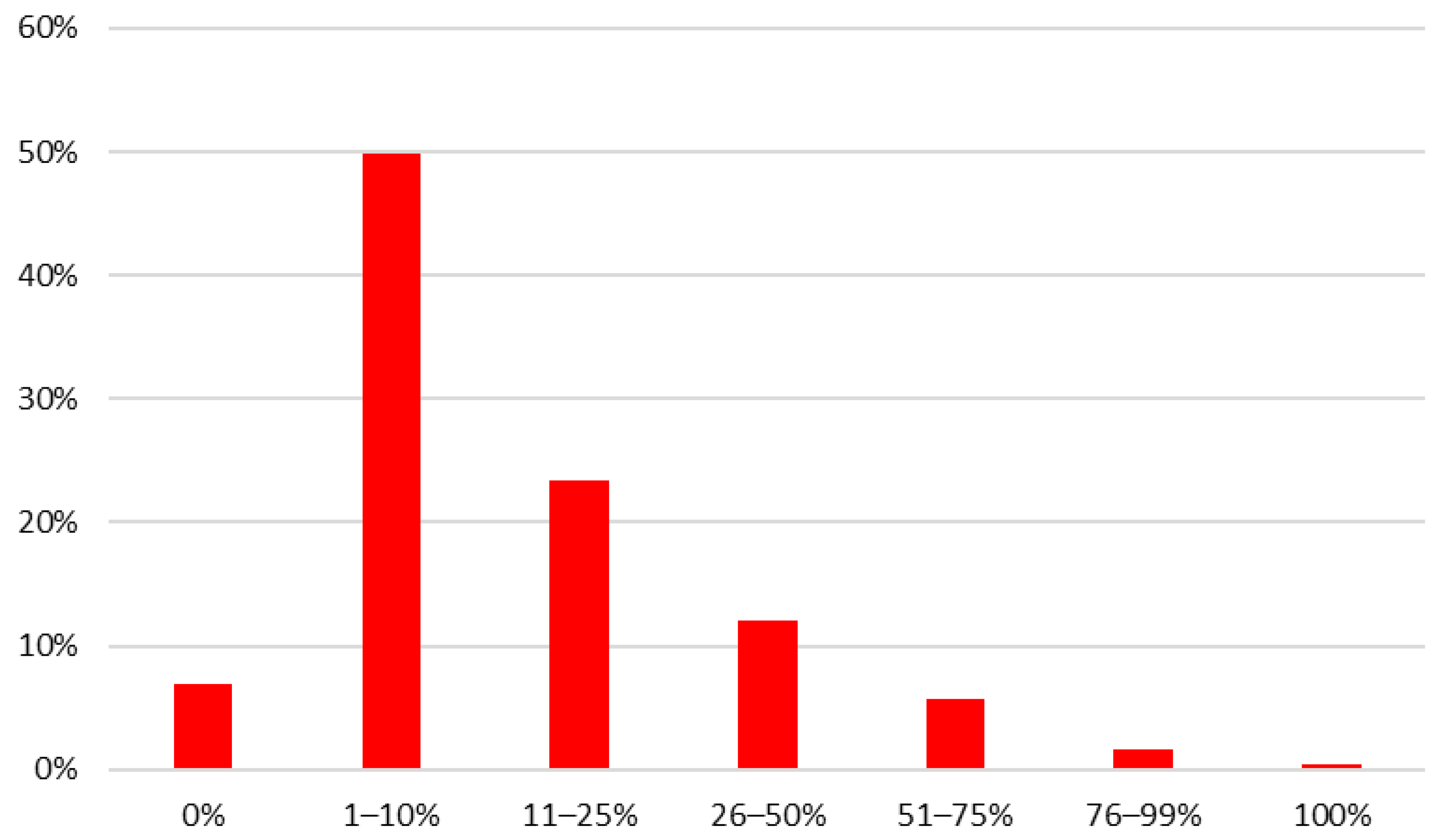

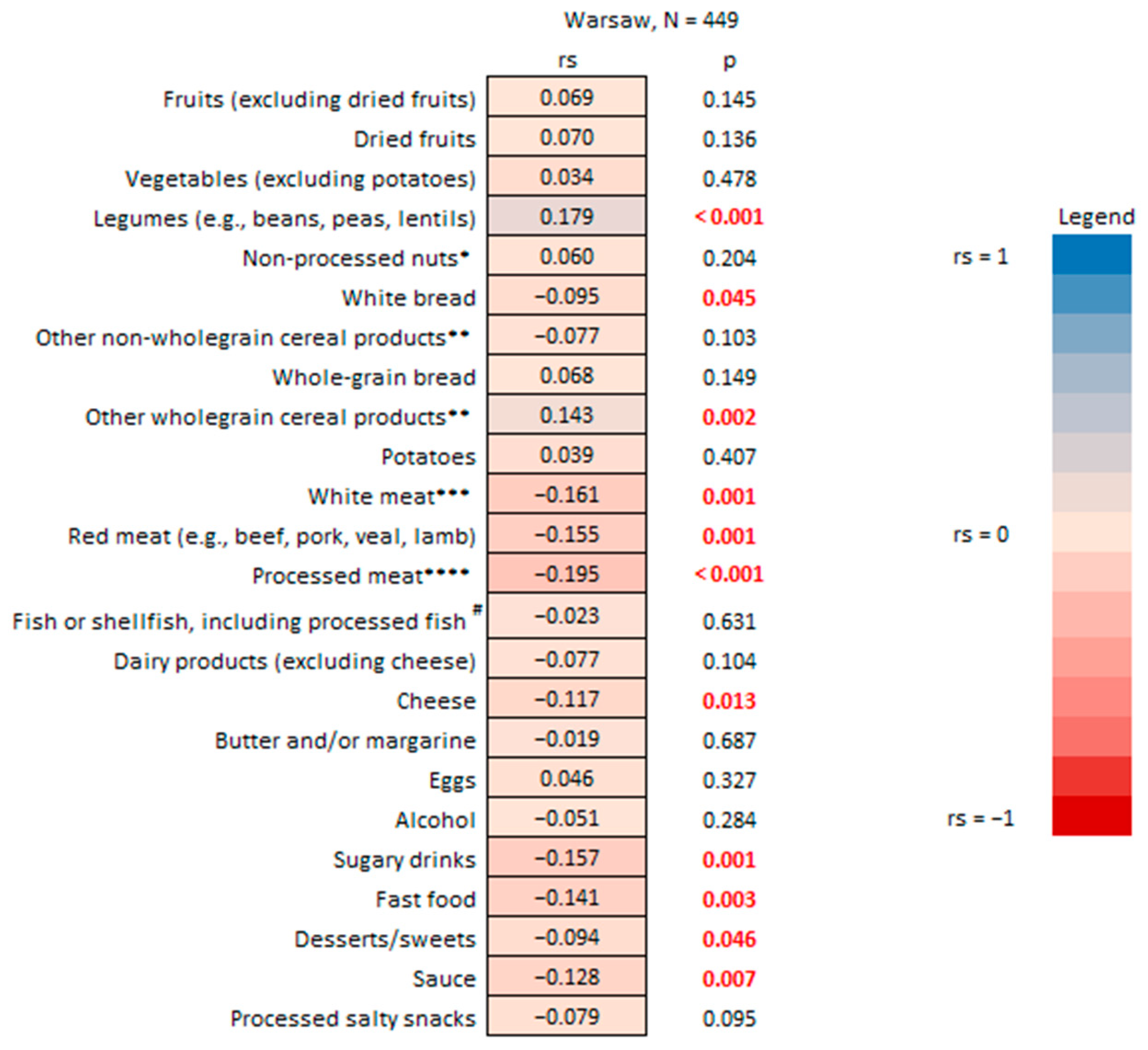
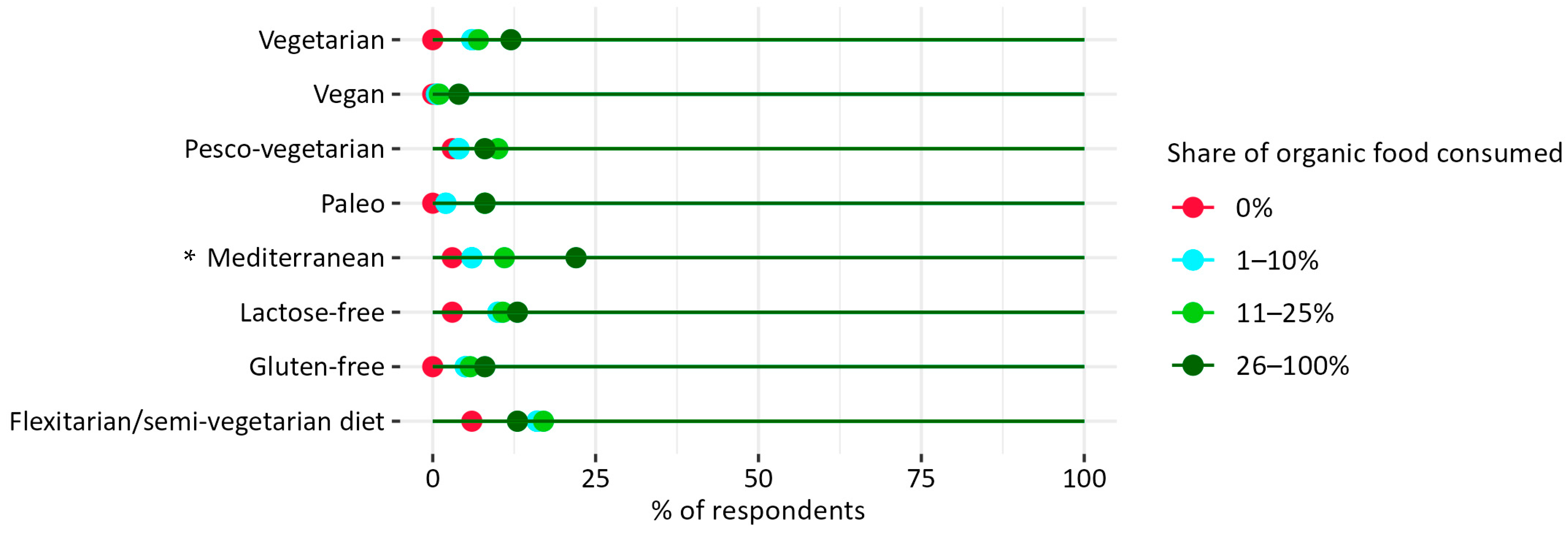


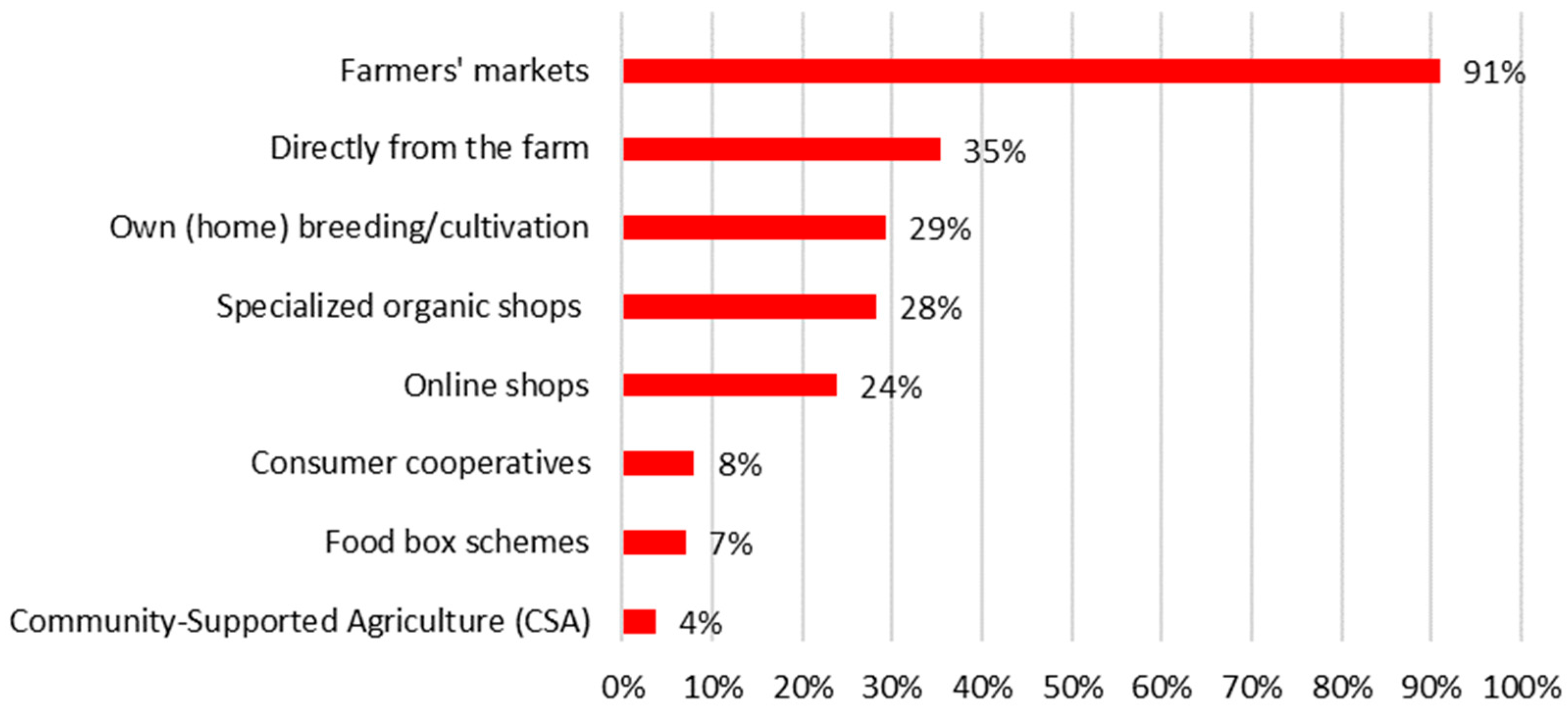

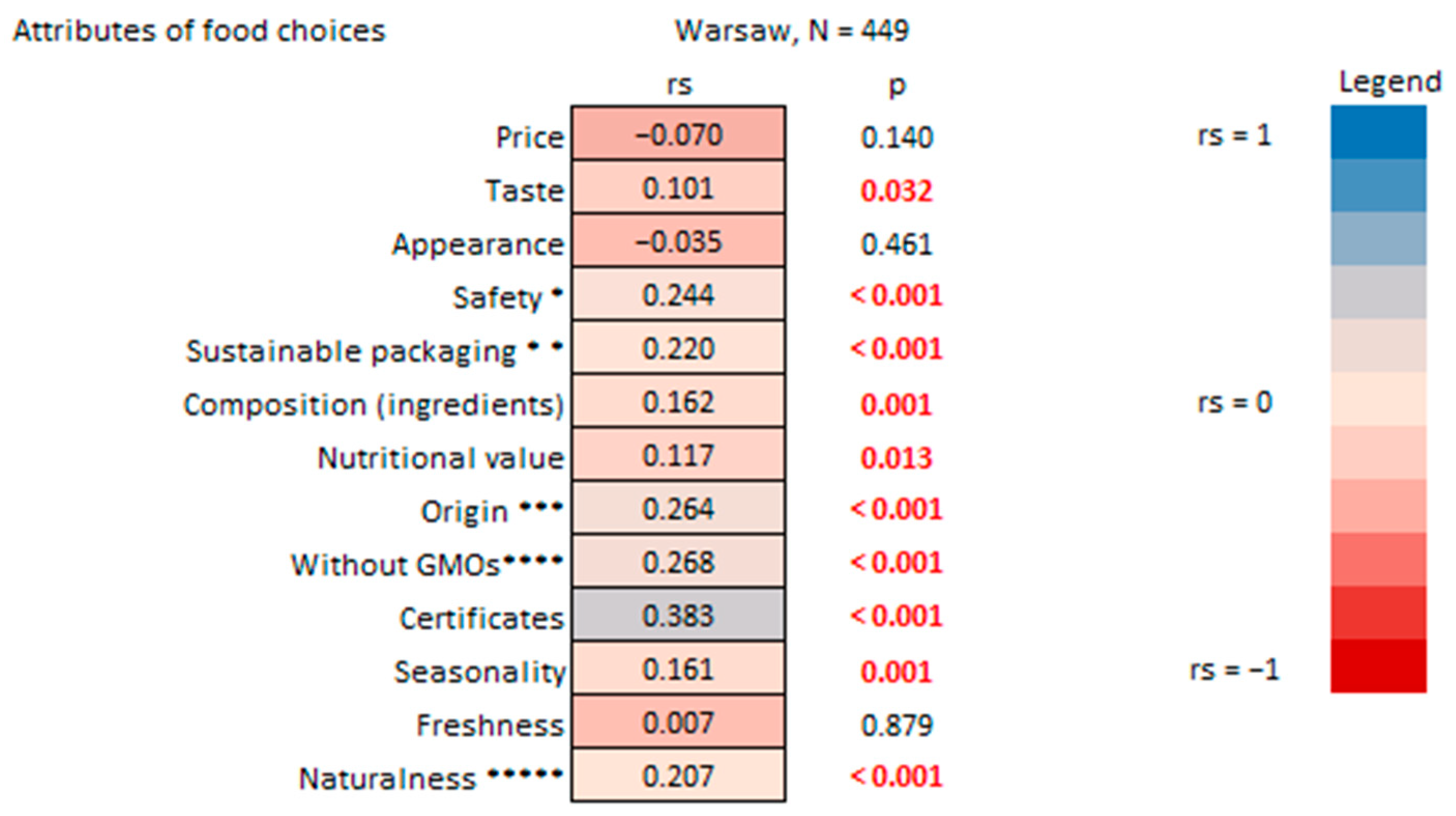

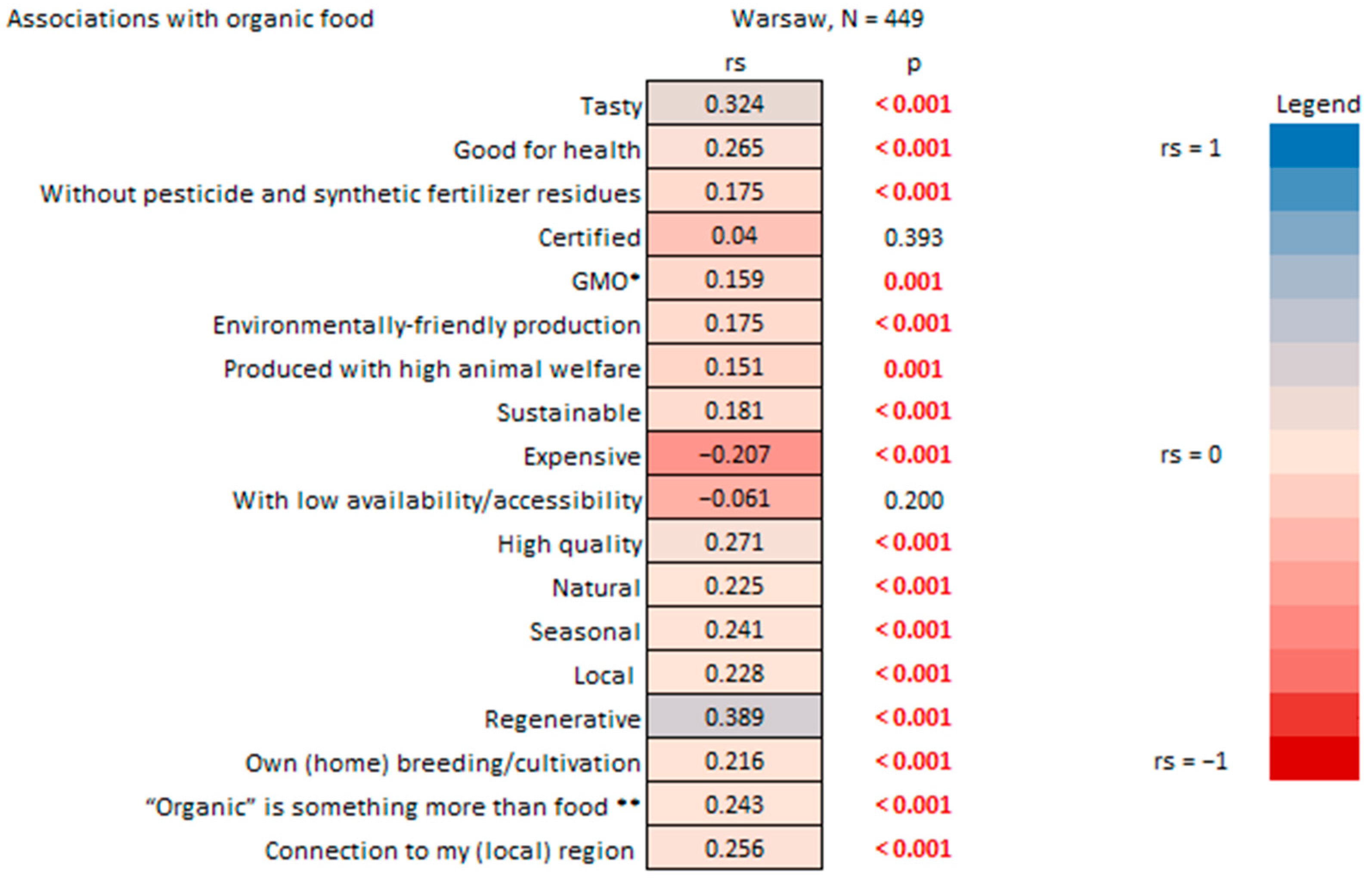
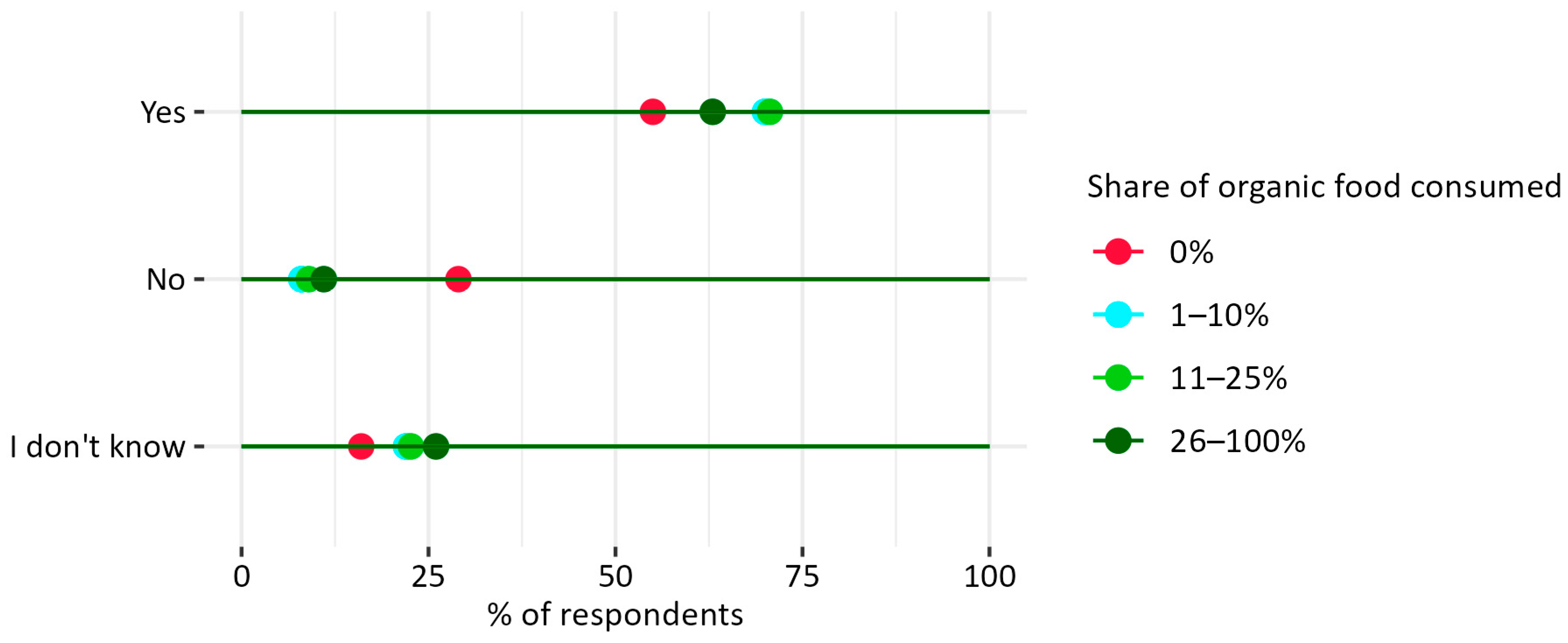
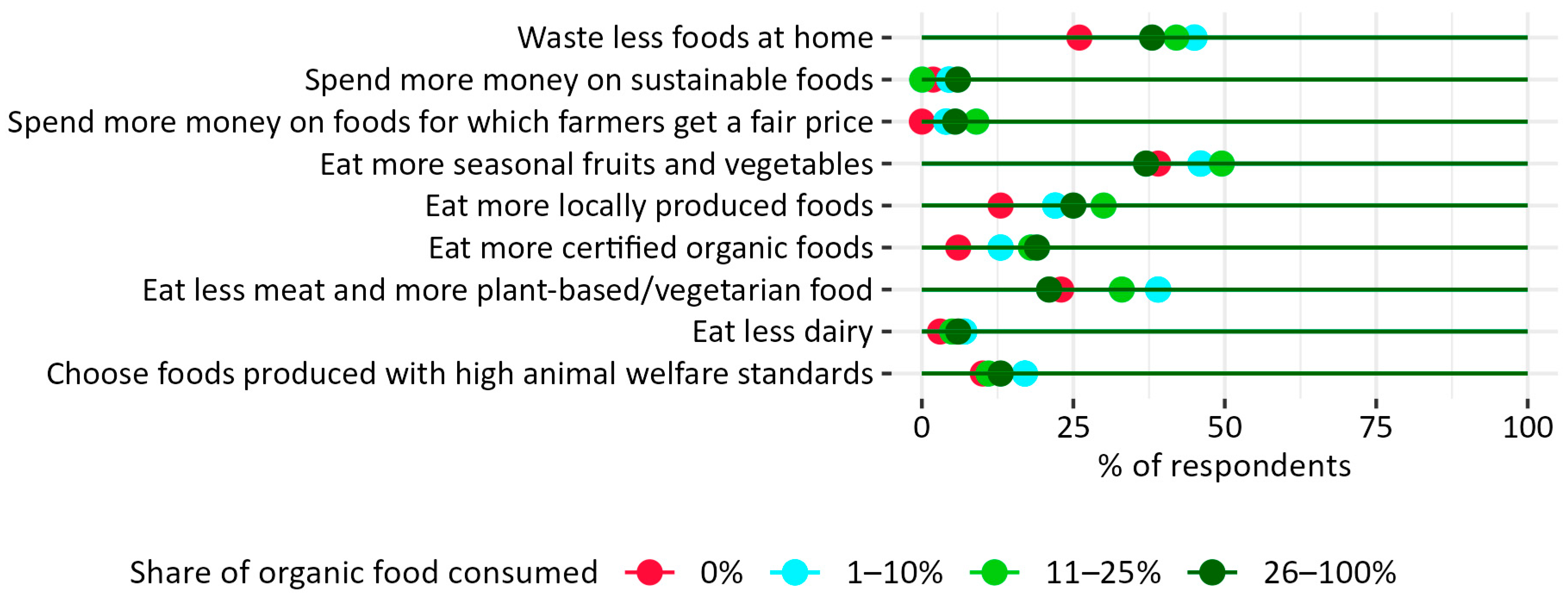
| Variables | rs | p * |
|---|---|---|
| DP 1 (meat and eggs) | −0.148 | 0.002 |
| DP 2 (fruits, vegetables, legumes, not processed) | 0.143 | 0.002 |
| DP 3 (processed food and fast food) | −0.123 | 0.009 |
| DP 4 (dairy, including cheese and butter) | −0.108 | 0.022 |
| DP 5 (white bread and non-whole grain cereal products) | −0.055 | 0.241 |
| DP 6 (whole bread and whole grain cereal products) | 0.067 | 0.157 |
| DP 7 (alcohol) | 0.071 | 0.132 |
Disclaimer/Publisher’s Note: The statements, opinions and data contained in all publications are solely those of the individual author(s) and contributor(s) and not of MDPI and/or the editor(s). MDPI and/or the editor(s) disclaim responsibility for any injury to people or property resulting from any ideas, methods, instructions or products referred to in the content. |
© 2025 by the authors. Licensee MDPI, Basel, Switzerland. This article is an open access article distributed under the terms and conditions of the Creative Commons Attribution (CC BY) license (https://creativecommons.org/licenses/by/4.0/).
Share and Cite
Góralska-Walczak, R.; Stefanovic, L.; Kazimierczak, R.; Kopczyńska, K.; Matthiessen, L.E.; Strassner, C.; Peronti, B.; Pugliese, P.; El Bilali, H.; Aboussaleh, Y.; et al. Is Organic Food Consumption Associated with Other Sustainable Food-Related Behaviors? Insights from a Survey in the Capital City of Poland. Nutrients 2025, 17, 2113. https://doi.org/10.3390/nu17132113
Góralska-Walczak R, Stefanovic L, Kazimierczak R, Kopczyńska K, Matthiessen LE, Strassner C, Peronti B, Pugliese P, El Bilali H, Aboussaleh Y, et al. Is Organic Food Consumption Associated with Other Sustainable Food-Related Behaviors? Insights from a Survey in the Capital City of Poland. Nutrients. 2025; 17(13):2113. https://doi.org/10.3390/nu17132113
Chicago/Turabian StyleGóralska-Walczak, Rita, Lilliana Stefanovic, Renata Kazimierczak, Klaudia Kopczyńska, Lea Ellen Matthiessen, Carola Strassner, Benedetta Peronti, Patrizia Pugliese, Hamid El Bilali, Youssef Aboussaleh, and et al. 2025. "Is Organic Food Consumption Associated with Other Sustainable Food-Related Behaviors? Insights from a Survey in the Capital City of Poland" Nutrients 17, no. 13: 2113. https://doi.org/10.3390/nu17132113
APA StyleGóralska-Walczak, R., Stefanovic, L., Kazimierczak, R., Kopczyńska, K., Matthiessen, L. E., Strassner, C., Peronti, B., Pugliese, P., El Bilali, H., Aboussaleh, Y., & Średnicka-Tober, D. (2025). Is Organic Food Consumption Associated with Other Sustainable Food-Related Behaviors? Insights from a Survey in the Capital City of Poland. Nutrients, 17(13), 2113. https://doi.org/10.3390/nu17132113












